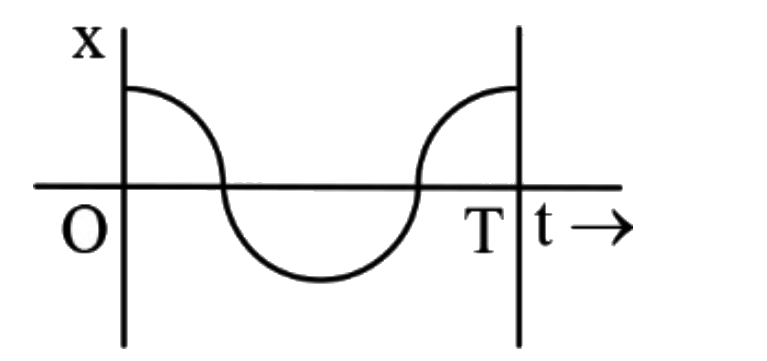A simple harmonic oscillation has an amplitude A and time period T. The time required to travel from x=A to x=A2 is
T6
T4
T3
T12
The correct Answer is:A
To solve the problem of finding the time required for a simple harmonic oscillator to travel from x=A to x=A2, we can follow these steps:
1. Identify the Displacement:
The initial position is x=A and the final position is x=A2. The displacement y can be calculated as:
y=A−A2=A2
2. Use the Equation of Motion:
The equation for displacement in simple harmonic motion is given by:
y=Acos(ωt)
where ω is the angular frequency.
3. Determine the Angular Frequency:
The angular frequency ω is related to the time period T by the formula:
ω=2πT
4. Set Up the Equation:
Substitute y=A2 into the equation:
A2=Acos(2πTt)
5. Simplify the Equation:
Dividing both sides by A (assuming A≠0):
12=cos(2πTt)
6. Find the Angle:
The cosine of 2πTt equals 12. The angle whose cosine is 12 is:
2πTt=π3
(This corresponds to the first quadrant solution.)
7. Solve for Time t:
Rearranging the equation gives:
t=T6
Final Answer:
The time required to travel from x=A to x=A2 is:
t=T6
The initial position is x=A and the final position is x=A2. The displacement y can be calculated as:
y=A−A2=A2
The equation for displacement in simple harmonic motion is given by:
y=Acos(ωt)
where ω is the angular frequency.
The angular frequency ω is related to the time period T by the formula:
ω=2πT
Substitute y=A2 into the equation:
A2=Acos(2πTt)
Dividing both sides by A (assuming A≠0):
12=cos(2πTt)
The cosine of 2πTt equals 12. The angle whose cosine is 12 is:
2πTt=π3
(This corresponds to the first quadrant solution.)
Rearranging the equation gives:
t=T6
The time required to travel from x=A to x=A2 is:
t=T6
Topper's Solved these Questions
- SIMPLE HARMONIC MOTIONBook:DC PANDEY ENGLISHChapter:SIMPLE HARMONIC MOTIONExercise:Level 1 Subjective
Explore 39 Videos
- SIMPLE HARMONIC MOTIONBook:DC PANDEY ENGLISHChapter:SIMPLE HARMONIC MOTIONExercise:Level 2 Single Correct
Explore 28 Videos
- SIMPLE HARMONIC MOTIONBook:DC PANDEY ENGLISHChapter:SIMPLE HARMONIC MOTIONExercise:Level 1 Assertion And Reason
Explore 10 Videos
- SEMICONDUCTORS AND ELECTRONIC DEVICESBook:DC PANDEY ENGLISHChapter:SEMICONDUCTORS AND ELECTRONIC DEVICESExercise:More than One Option is Correct
Explore 3 Videos
- SOLVD PAPERS 2017 NEET, AIIMS & JIPMERBook:DC PANDEY ENGLISHChapter:SOLVD PAPERS 2017 NEET, AIIMS & JIPMERExercise:Solved paper 2018(JIPMER)
Explore 38 Videos
Similar Questions
A simple harmonic motion has an amplitude A and time period T. Find the time required bu it to trvel directly form
(a) x=0 to x=A/2
(b) x=0 to x=A√2
View SolutionA simple harmonic motion has an amplitude A and time period T. Find the time required bu it to trvel directly form
(a) x=0 to x=A/2
(b) x=0 to x=A√2
(c) x=A to x=A/2
(d) x=−A√2 "to" x=A√2
(e) x=A√2 to x=A.
View Solution
Knowledge Check
A particle executing simple harmonic motion with an amplitude 5 cm and a time period 0.2 s. the velocity and acceleration of the particle when the displacement is 5 cm is
A0.5πms−1,0ms−2B0.5ms−1,−5π2ms−2C0ms−1,−5π2ms−2D0.5πms−1,−0.5π2ms−2
A simple harmonic motino has amplitude A and time period T. The maxmum velocity will be
View SolutionA simple pendulum performs simple harmonic motion about x=0 with an amplitude a ans time period T. The speed of the pendulum at x=a2 will be
View SolutionA particle is executing simple harmonic motion with an amplitude A and time period T. The displacement of the particles after 2T period from its initial position is
View SolutionA particle executes simple harmonic oscillation with an amplitudes a. The period of oscillation is T. The minimum time taken by the particle to travel half of the amplitude from the equilibrium position is
View SolutionA particle executes simple harmonic oscillation with an amplitudes a. The period of oscillation is T. The minimum time taken by the particle to travel half of the amplitude from the equilibrium position is
View SolutionA body is performing simple harmonic motion of amplitude A and time period T. The figure shown position-time graph of the body . At any time t, acceleration of the body is f, then which of the following graphs is/are appropriate?

View SolutionA particle executes simple harmonic motion with an amplitude of 10 cm and time period 6s. At t=0 it is at position x=5 cm going towards positive x-direction. Write the equation for the displacement x at time t. Find the magnitude of the acceleration of the particle at t=4s.
View Solution

